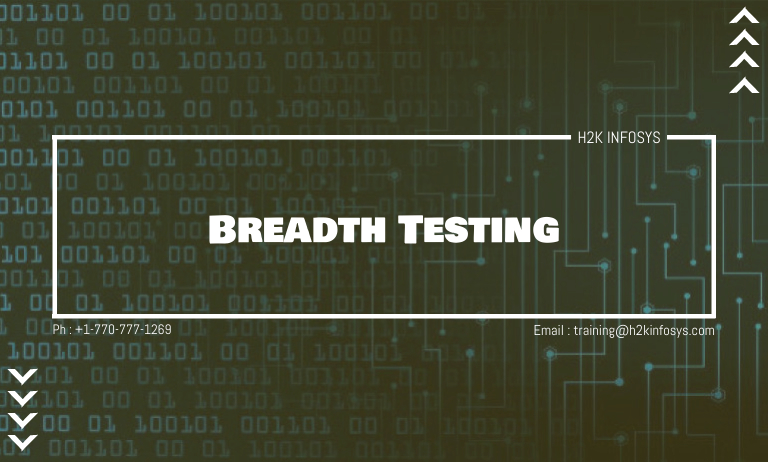What is Breadth Testing?
Breadth testing is a software testing approach that focuses on validating the basic functionality of a wide range of features in a software system, without delving deeply into any specific functionality. The aim is to ensure that all the main features work as expected, at least at a surface level, before deeper tests are conducted. For instance, if you are testing a banking application, breadth testing would involve quickly verifying that users can log in, transfer funds, check their balance, and view transaction history, but it wouldn’t necessarily test all the intricate details or edge cases for each function. In other words, breadth testing is about coverage across features, rather than exploring each feature in depth.
It is one among the Qa Software testing course which will be utilised by the team of knowledgeable and proficient testers to test the basic features of the software when properly checking and also verifying the functionality of the same.
Why Breadth Testing Matters
Breadth testing is critical for several reasons, especially during the early stages of the software development lifecycle. Here are a few key reasons why breadth testing matters:
Early Detection of Major Bugs: By testing a wide range of functionalities early on, testers can quickly identify critical issues across the system. This ensures that major blockers are caught before deeper testing is conducted.
Ensures Basic Functionality: Before diving into detailed test cases, breadth testing ensures that the most basic operations of the system work correctly. This avoids wasting time on in-depth testing of a feature that may not even function at a basic level.
Risk Mitigation: When multiple features are tested at a high level, developers can prioritize fixing high-risk areas that affect the overall functionality of the system.
Efficient Use of Resources: In a time-crunch, especially during early iterations of agile projects, breadth testing allows testers to cover a large area of the system without the need for extensive resources.
Breadth Testing Techniques
Several techniques can be used to conduct effective breadth testing. Here are the most common ones:
Smoke Testing
Often referred to as “sanity testing,” this technique checks if the most critical functions of a software system work. It’s essentially a subset of breadth testing where only the “must-have” features are tested.
Exploratory Testing
This is a manual testing approach where testers explore the software and test different features on the go, without predefined test scripts. It’s useful for getting an overall sense of the system’s functionality and identifying areas that need more attention.
Happy Path Testing
This involves testing the system’s most straightforward and expected flows, ensuring that common use cases work without delving into more complicated scenarios or edge cases.
Ad-Hoc Testing
Ad-hoc testing is an informal, unstructured method where testers interact with different areas of the software to uncover basic issues. This form of testing can reveal bugs that structured testing might overlook.
Breadth Testing Tools
While manual testing is often used for breadth testing, automation tools can greatly increase the efficiency and coverage of testing. Some of the most popular tools for breadth testing include:
Selenium
An open-source tool widely used for automating web applications. Selenium can be used to conduct high-level tests on different features, making it a great tool for breadth testing.
TestComplete
TestComplete allows testers to create automated UI tests for web, desktop, and mobile applications. It can quickly cover a wide range of functionalities, making it ideal for breadth testing.
Postman
For API-based applications, Postman is an excellent tool to test the breadth of API functionality. It allows testers to quickly verify that different endpoints function correctly at a basic level.
Jenkins
Jenkins can be integrated with various testing tools to automate breadth testing across different features of an application, ensuring that new builds don’t break critical functionality.
Breadth Testing in Integration testing:
Integration testing may be done in many ways. But two of best possible way to implement on any software product are Top-down approach and Bottom up approach. Breadth-first testing or depth-first testing which can be done by the top-down approach. Top-down approach is an incremental approach to construct program structure, where modules are integrated by moving downwards from the control hierarchy starting with main control module. These modules subordinate to the main control module which are incorporated into the structure in either a breadth first or depth first manner. Breadth first integration incorporates all components to subordinate at every level while moving across the structure horizontally.
Uses of Breadth–First testing
While the software development and testing process in breadth testing is used to test and validate the full functionality of the software as well as to make sure that detailed testing is performed on the software. There are many testing techniques which use these test suites for many reasons. Breadth testing is important in testing the quality of the software. In some situations breadth testing is given more importance. There are some software testing techniques in which breadth testing suite is used in various context.
- Sanity Testing
It is a surface level testing where quality assurance engineer validates the product is working fine. Here breadth first is usually used to test and validate the functionality of the product.
- Functional Testing:
It is a combination of both Breadth-first and Depth-first testing to check the software’s functionality. The main aim of breadth-first testing is checking all the features which will be tested in detail through depth-first testing.
- Automation:
Automation Qa courses is used of special software to control the execution of test and also comparison of actual with predicted outcomes. It uses breadth and depth testing to decide whether to automate end to end testing.
For example.
Top down testing with Breadth-first are
- M1
- M2,M3,M4
- M5,M6,M7
- M8
Conclusion
Breadth testing is a vital component of any software testing strategy. By focusing on covering a wide range of features at a high level, breadth testing ensures that all major functionalities work correctly before more intensive, detailed testing is conducted. It helps identify critical issues early, mitigates risk, and ensures the efficient use of resources.
While it has its challenges, when combined with other testing approaches such as depth and regression testing, breadth testing provides a well-rounded view of the software’s overall health. Whether you’re working in an agile environment or conducting automated testing, breadth testing remains a foundational part of ensuring software quality.




























8 Responses
Breadth testing is a testing suite that will validate the full functionality of a product but does not test the product features in detail.
Breath testing is a testin g suite which will validate the functionality of product .but it does not test the product features in detail.It is used in various testing techniques including sanity testing and functional testing.
Breadth testing is used check the functionality of the program .I t doesn’t Check the features in detail.
Breadth Testing involves testing the crucial functionality of a program or a software but it does not dwell on testing the finer details of an application. This test is similar to Smoke testing, Build acceptance testing or Build verification testing. Through this testing we are trying to achieve high level analysis of the application.
Breath testing is a testing suite which will validate the functionality of product .but it does not test the product features in detail. It is used in various testing techniques including sanity testing and functional testing.
Breadth Testing is a test suite that validates the full functionality of a product but does not test the product features in detail.
Breadth testing is a testing suite that will validate the full functionality of a product but does not test the product features in detail. Breadth testing is important in testing the quality of the software. It is one among the techniques in software testing, which will be utilized by the team of knowledgeable and proficient testers to test the basic features of the software when properly checking and also verifying the functionality of the same.
Breadth testing is a testing suite that will validate the full functionality of a product but does not test the product features in detail.
It is one among the technique in software testing, which will be utilized by the team of knowledgeable and proficient testers to test the basic features of the software when properly checking and also verifying the functionality of the same.